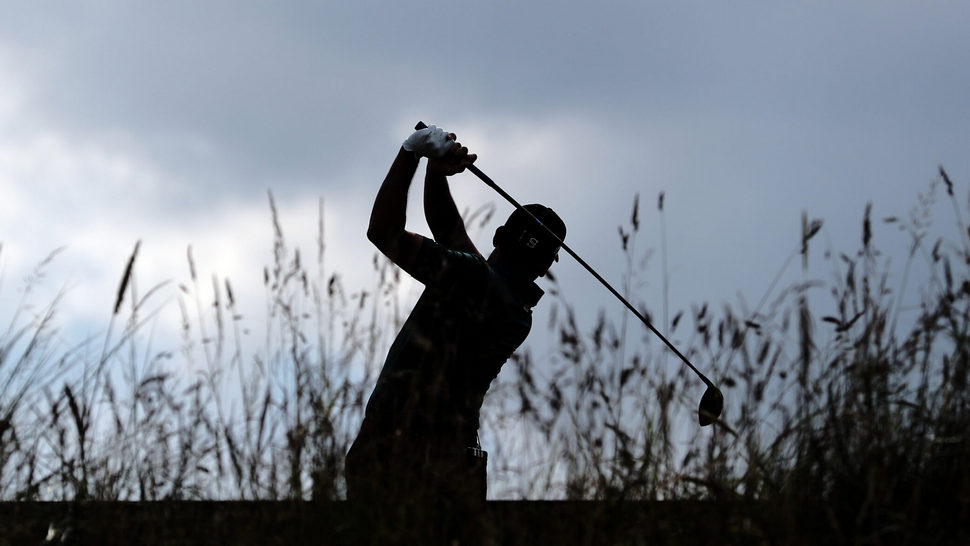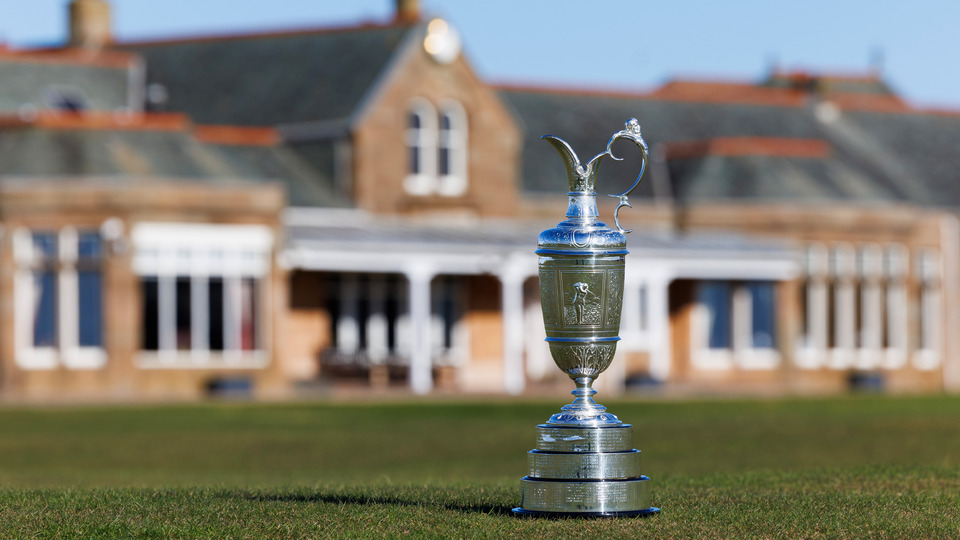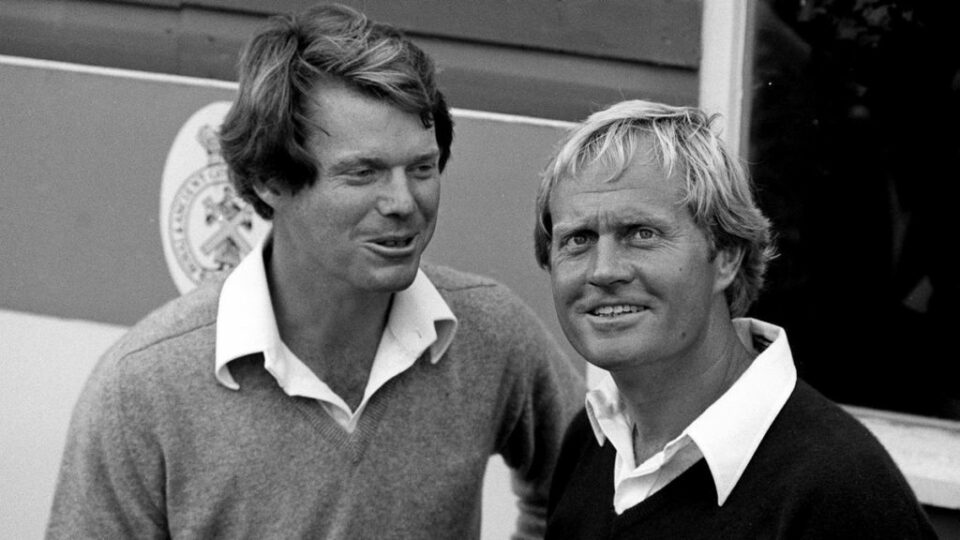There has been a trend of late towards emphasising the speed of hip rotation in the recoil as a means of generating power – a swing thought guaranteed to be ruinous for the vast majority of amateur golfers. As the greatest swingers of the club have proved time and again down the ages, the secret to consistently solid and accurate ball striking lies in controlling your overall motion with a coordinated rotation of the body that sees the hips and shoulders wind and unwind ‘in sync’ – i.e. neither one out-races the other. The key to achieving this lies in maintaining the stability of your swing ‘centre’ – your pelvis. Quite simply, if the pelvis gets out of position, then so does everything else. The better you stabilise this relationship, the better you will ‘sequence’ your body rotation, and the less you will need to rely on hand action through the impact area
By Jonathan Yarwood
Stretching a point: Stabilise your hip action for consistent recoil
As a trainee instructor under David Leadbetter in the late 1980s and early 1990s, I couldn’t have enjoyed a better education in the golf swing; one of the perks of the job was working extensively with Nick Faldo, and watching one of the all-time greats go about controlling the rhythm and the tempo of his swing with a rocksolid body action instilled in me an understanding as to how the body pivot should work.
Through the coordinated rotation of the bigger muscles (the shoulders/torso over the resistance of the hips/thighs), Nick created the framework around which the arms could swing the club on a perfectly neutral path and plane.
Faldo, perhaps more than any other player in modern times, had the uncanny ability to finetune the speed of his swing with the rotation of his body; most important of all, neither half ever dominated the other. And he was meticulous in maintaining his ‘levels’.

In my teaching I place a great store of emphasis on the correct ‘sequencing’ of the rotation between the key components of the body (the knees, hips, chest and shoulders), and I am going to share with you a series of drills that will give you a better understanding of this dynamic – and help you recognise the stability of the pelvis as being vital to the overall quality of your motion.
As per the main image on the opposite page, the key is that you get the hips and shoulders to more or less match up at impact (in reality, the hips will be a little more open to the target – but as a visual this will help you bring them closer in to line). If the lower body flies off the handle, and you lose that stability in the pelvis, the upper body gets left behind, ending up too square approaching impact – a fault that necessitates a recovering hand action through the ball.
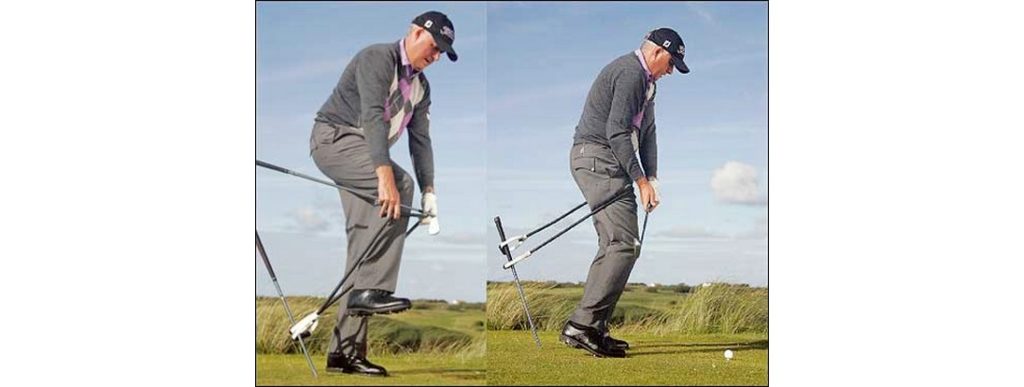
(right) No! Raising the pelvis leads to loss of spine angle, and the arms get stuck and out of kilter with the body

The beauty of these drills is that they will help to raise your awareness of the relationship between the two halves of your body, and, specifically, the stabilising role of the pelvis in maintaining your ‘levels’. As you develop a more stable lower body action, so you will repeat a more solid golf swing.
Mind the gap
At address there should be a reasonable gap between your arms and your pelvis (indicated here by the foam training ball on the end of a shaft that I have placed just inside my right foot). Now, in a good golf swing, that clearance is maintained through impact as a result of the body unwinding and rotating correctly, allowing the arms the freedom to swing freely through impact. Clearly, having that object just opposite your right thigh makes you aware of the correct path of the hands and arms on their way to impact – get off the right side too early, lose that stability in the pelvis, and you are on a crash course!

(centre) Body angles nicely maintained into the backswing. Now a case of ‘holding’ the hips and pelvis, waiting for the left knee to initiate the transition
(right) Key is to stay on the right foot a little longer so that hips and torso match up, allowing the arms the space to swing freely through
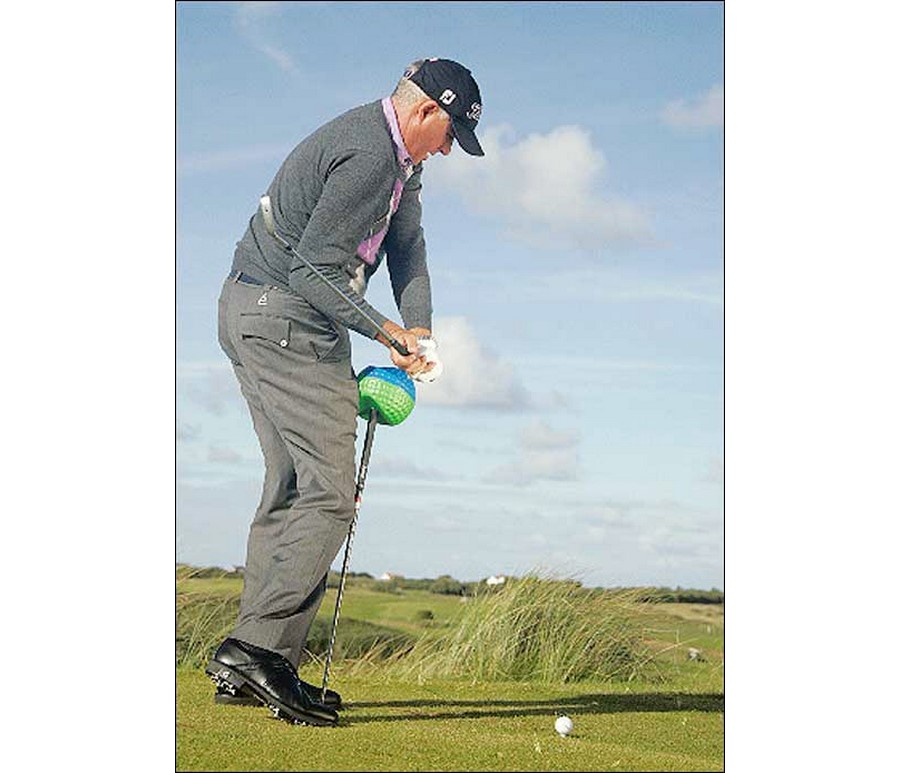
Leg stabilisation through the transition: Stretch, separate & settle
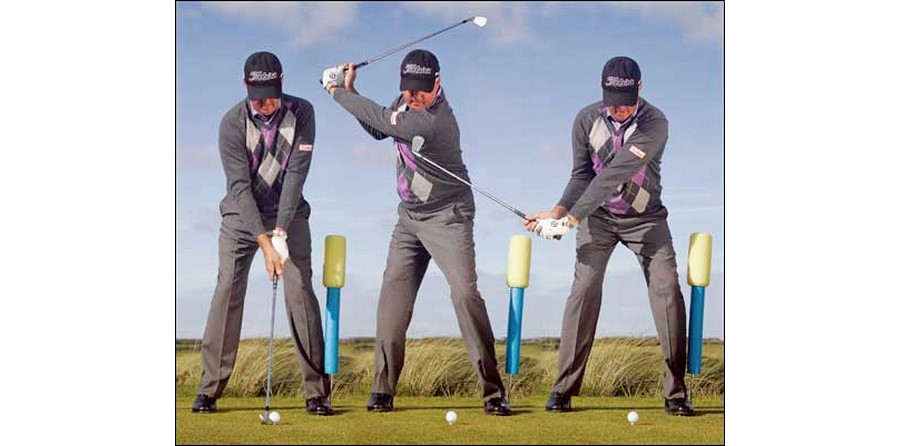
(centre) Taking it to the top, the hips rotate to facilitate the full turn of the shoulders...
(right) ...the left thigh then separates from the right to create this squat move, containing the energy ahead of the final thrust to impact
Eliminate the slide, and learn to rotate your hips back to the ball
Sliding the hips and pelvis laterally toward the target – then spinning them excessively approaching and through impact – is another nono. This creates instability in the lower body which threatens to change the spine angle and creates the need for compensation – i.e. the hands have to find a way of planting the club on the ball.
In a sound swing, the hips wind up and gather energy via a player’s interaction with the ground – there is a resistance in the feet, knees and quads which engages the internal muscles of the abs and core in creating coil to generate power. In order to translate this stored energy into speed through the arms, clubshaft and, ultimately, the clubhead, it has to be harnessed and channelled correctly – i.e. in sequence. Let it off the bridle too early (too quickly) and the energy disappears into the wrong areas.
Look carefully at the images in the sequence above. At the top of the backswing (2) I am nicely wound up – not overly active with my legs but active and supportive enough. The next image in the sequence is key; the left knee initiates the change in direction as the right leg holds for a split second, creating a ‘squatty’ look. Sam Snead, Nick Faldo… Study every great swinger of the golf club and you will recognise this ‘squat’ position as being a common denominator. This is the dynamic action via which a good player contains and controls the flow of energy as it changes direction; here, it is still ‘loaded’, but above all, the pelvis is stabilising itself as it stretches away from the upper body.
Now, if the hips keep on rotating back towards the target the upper body will never have a chance to catch up, and as a result the hips and legs arrive at impact too soon (causing them to slow down at precisely the moment you want them accelerating). They have to wait for the unwinding of the torso and the swinging arms to catch up. To eliminate this tendency, it is vital the lower body ‘holds’ for that split second in the transition, allowing the upper body to synchronise its subsequent movement through the ball.
Get this subtle move right, and that final burst of rotational speed with the body core closes the gap between the ‘stretch’ and ‘separation’ that the lower body created in the transition from the top of the swing. This dynamic allows the body as a whole to keep on moving and rotating through the ball, the perfect timing of all the key components.

Pinch the knees, and sense the way the legs control the move down
This particular drill was one Nick Faldo would literally spend hours and hours on, honing the leg action that would both support and stabilise the rotation of the upper body. All you need is a piece of resistance band adjusted to fit around your thighs, just above the knees, so that at the set-up you feel some tension. You wnat to then keep it that way as you then turn and complete your backswing – you want to feel ‘grounded’.
From the top, it’s then a case of negotiating the separation and the ‘squat’ in the lower body that characterises all great ball strikers. See how the band around my legs remains taut as the left knee initiates the energy transfer back towards the target.
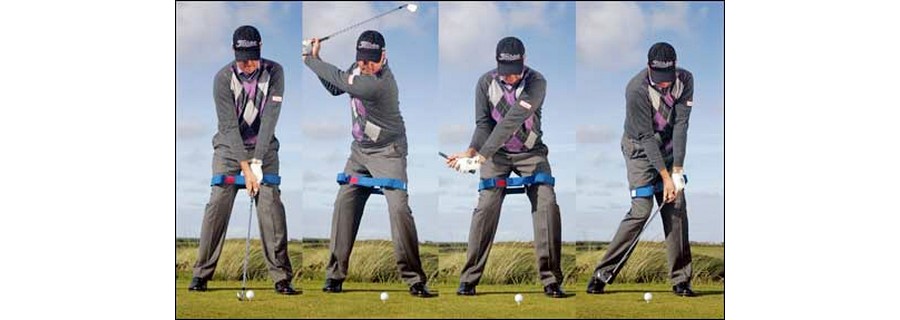
(left) Keep that band taut as you wind up your backswing, thus stabilising the move with strength in your lower body
(centre) Feel the tension in the band still as you ‘settle’ into the downswing – the ‘squat’ that is the mark of a good player
(right) Then, in tandem with the rotation of the upper body, the right knee and hip add thrust to the hit
When you get this right you will enjoy a wonderfully stable platform through the synchronisation of the two halves of the body. Make a mental note of this: the hips do not slide into the change of direction and keep on going; they ‘settle’ in the transition, ‘hold’ to contain the power, and then ‘fire’ through impact.
All about angles
Here’s another great exercise that will challenge your ability to keep your pelvis in place – and thus the consistency of your spine angle as you work your way through the transition and into the critical areas of the downswing. On the range, try to hit some shots with your golf bag placed directly behind you, so that as you set-up to the ball your rear-end is just touching the bag. The key, then, is to maintain that contact, at least until impact and, ideally, even into the finish.
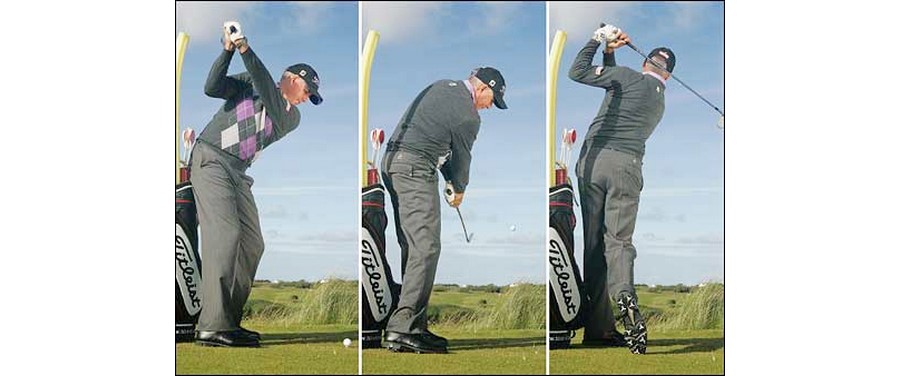
You will be surprised how hard it is to do (as I have proved here, moving fractionally off it through impact. Must try harder!)
Improved lower body action helps you to deliver the club on plane
I want you to study closely the two images above. In the left-hand photo, you can clearly see the hips are square to the target while my chest is still turned towards the camera. As a result of a good transition, the arms fall nicely into the delivery position, and the important thing now is that, with the legs stable at this point, the arms have the time they need to relocate and catch up with the rotating torso through impact.
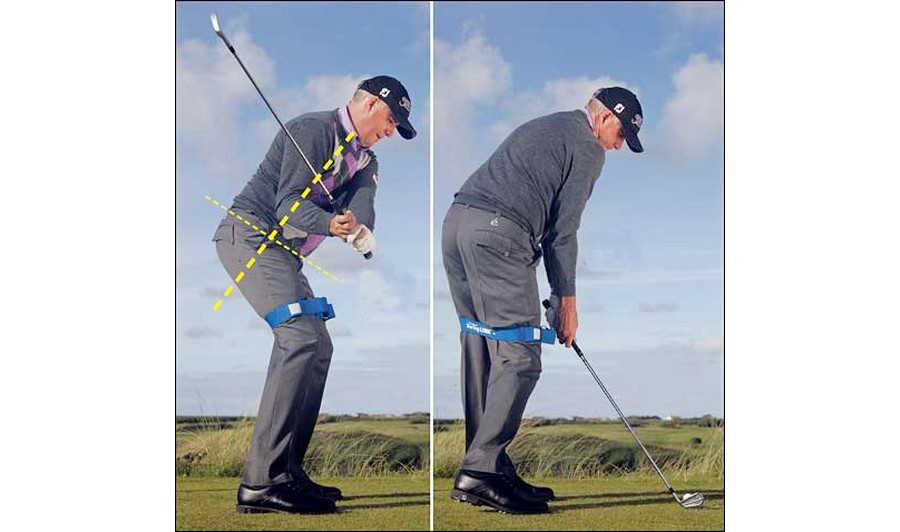
(right) Spine and pelvic angle maintained, allowing the right side of the body to ‘cover’ the ball
As you can see in the staging of impact (right photo), this ‘sequencing’ of the downswing allows the body to open and explode through the ball with the torso and the arms continuing to move through impact together (rather than the body having to recoil and stop to allow the arms to catch up). All of the drills featured here are designed to help you similarly maintain your pelvic stability and spine angle, so that the sequence of your body turn works around a consistent axis.
To summarise the key message here, you really do have to make sure you avoid the lower body out-racing the upper body; to achieve a solid and consistent position at impact, the two halves must match up.
Develop your feel for the power move
Here, the separation of the left thigh away from the right as I settle into the downswing has ‘loaded’ my arms, almost like a catapult being pulled back. From here, as the left leg straightens and ‘posts’, the right side of my body has the green light to fire (i.e. the catapult to be released) and the energy is channelled all the way down through the arms and club into the ball.
What you have to be careful of, however, is having too much stretch (i.e. too much disassociation between the lower and the upper body). You can get too much of a good thing: if the lower body were to continue to pull away towards the target, stretching out the band in the process, the upper body would get left behind, and at some point the lower body would have to slow down to allow it to catch up. This obviously affects a player’s potential for generating rotational speed through impact – not to mention the rhythm of the motion.
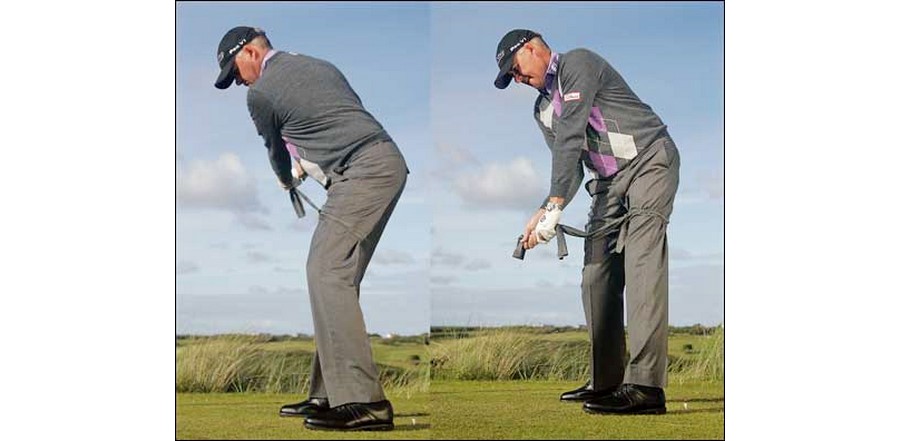
(right) As left leg ‘posts’ and you rotate through the impact area, tension in band is lost
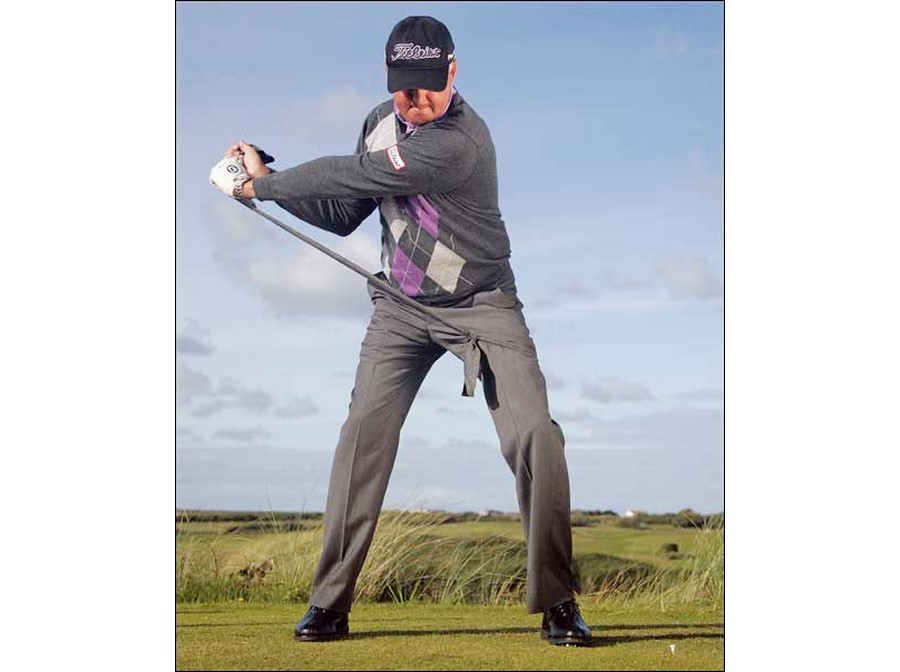
Look at how quiet the right foot is here – it stabilises the hips and does not allow them to get too far ahead. In fact, a great drill is to hit shots while trying to keep your right foot grounded – that will flag up any tendency to want to get off the rigth side too early
‘Cover’ the ball
Finally, a drill that rewards you with a real sensation of getting the upper body to catch up – to slam the door on the ball – as you harmonise lower and upper body through impact. Hit a few shots like this, with your right foot pulled back, up on its toe, and I guarantee you will understand what is meant by ‘covering’ the ball with your whole torso as you rotate and apply the power through impact.
As you see in this main image, the left leg ‘posts’ and weight moves onto the left heel. This allows the spine to remain in position, and allows the right side to fire. If the hips are out of sync, or if the pelvis is tucked under at this point, then the arms have nowhere to go.
Try hitting a few shots with just your right arm, also, pulling on your left hip pocket with the left. Keep your right foot as quiet as possible – feel the way it stabilises the hips and denies them the freedom to get too far ahead of the action. The result will be a wonderful sensation of having all the room in the world through impact.
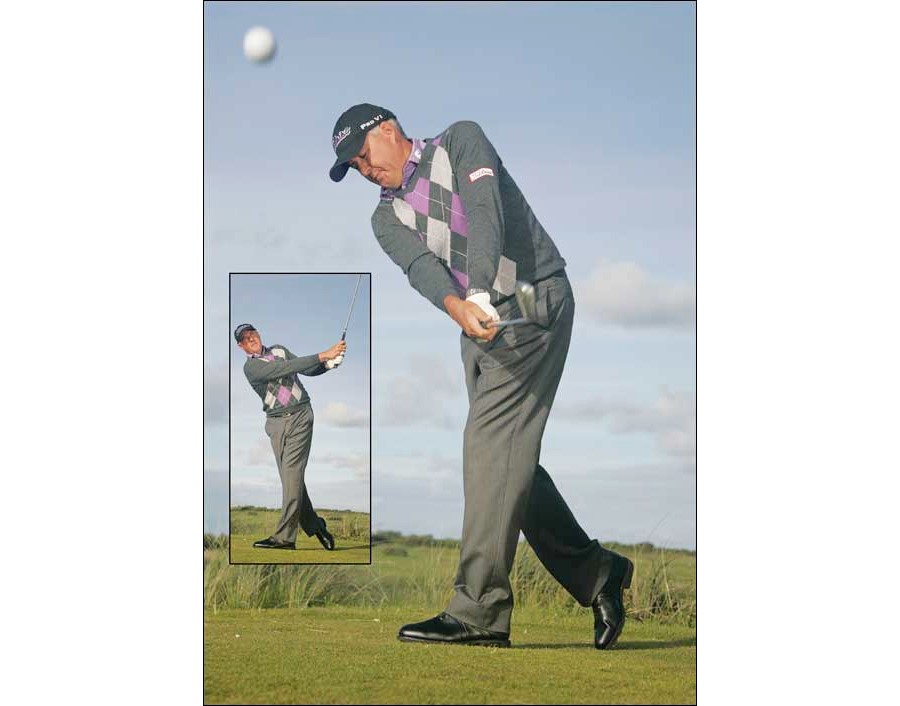
(inset) Coordinated to the finish – make this balance a trademark in your golf swing
